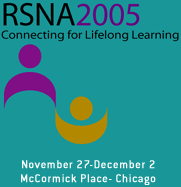
Abstract Archives of the RSNA, 2005
Ettore Squillaci MD, Abstract Co-Author: Nothing to Disclose
Marco Carlani MD, Abstract Co-Author: Nothing to Disclose
Sebastiano Fabiano MD, Presenter: Nothing to Disclose
Nicoletta Fusco MD, Abstract Co-Author: Nothing to Disclose
Matteo Stefanini MD, Abstract Co-Author: Nothing to Disclose
Giovanni Simonetti MD, Abstract Co-Author: Nothing to Disclose
To explore the possibilities of first-pass perfusion imaging in patients with focal liver lesions with a 64 channel multidetector row helical CT (MDCT).
In a total of 20 patients with hystologically known liver lesions (3 hemangiomas, 2 FNH, 10 metastases, and 5 HCC) perfusion imaging with a MDCT (GE Lightspeed VCT) of liver was performed. Single location dynamic scans were performed with 0.8 scan time and 1 sec repetition time in a single breath hold. The scan was begun simultaneously with a contrast bolus injection of 60 cc (370 mgI/ml) at a rate of 5 ml/sec. Two adjacent slices were reconstructed and parametrical images were calculated (perfusion CT software, GE). Region of interest (ROI) drawn over the aorta and portal vein were used as imputs. Tissue ROIs were drawn over the entire liver and the lesion. Arterial and portal perfusion values for each ROI were calculated from the time intensity curves. Blood Flow (BF), Blood Volume (BV), Mean Transity Time (MTT) and capillary Permeability Surface area product (PS) were calculated in the normal parenchyma and in the lesions.
Perfusion values of normal liver (BF: avg. 26.41, dev. 87.31; BV: avg. 3.64, dev. 10.32; MTT: avg. 14.96, dev. 34.90; PS: avg. 14.96, dev. 34.90) tissue corresponded to expected physiological ranges. A statistically significative difference was demonstrated for BV and MTT between benign and malignant lesions (hemangioma BF: avg. 819.39, dev. 296.62; BV: avg. 25.187, dev. 21.98; MTT: avg. 2.28, dev. 2.20 PS avg. 52.49, dev. 50.61. HCC BF: avg. 265.22, dev. 25.187; BV: avg. 20.04, dev. 20.18; MTT avg. 7.60, dev. 7.06; PS: avg. 38.85, dev. 39.73.cirrotic liver BF: avg. 27.43, dev. 81.41; BV: avg. 2.86, dev. 6.51; MTT: avg 4.37, dev. 8.65, PS: avg. 14.73, dev. 31.77. Metastases BF: avg. 34.10, dev. 34.76; BV: avg. 10.181, dev. 10.93; MTT: avg. 20.502, dev. 18.224; PS: avg. 45.66, dev. 45.74).
Initial results of our study imply that perfusion MDCT may be helpful to assess differential diagnosis between liver lesions. More patients are necessary to explore correlations between perfusion values and hystology.
Squillaci, E,
Carlani, M,
Fabiano, S,
Fusco, N,
Stefanini, M,
Simonetti, G,
CT Perfusion Studies of Liver Lesions with a 64-detector Row Scanner: Initial Clinical Results. Radiological Society of North America 2005 Scientific Assembly and Annual Meeting, November 27 - December 2, 2005 ,Chicago IL.
http://archive.rsna.org/2005/4410991.html

